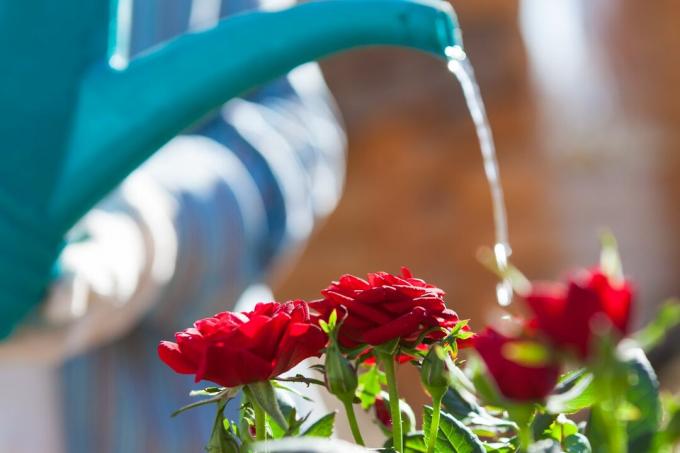In order for your roses to bloom properly, they need to be watered regularly. Here you can find out how often and how much you have to water your roses.

Come with dryness roses (pink) cope very badly. Finding a permanently wet soil just now roses in pot However, it is not particularly pleasant either, because waterlogging can lead to the formation of root rot and promote fungal diseases. For a rich flowering, optimal watering is therefore of great importance. In this article, we explain how to best proceed when watering roses.
Finding the right watering amount is not that easy with roses. We have summarized for you below when, how often and how much you should water roses.
When and how often are roses watered?
Regular watering is essential, especially for young and newly planted rose plants. On hot summer days and windy autumn days, however, older plants may also need to be watered. The best way to know when to water is with a finger test. The soil should always be moist, but not wet - and in the best case it should not even get so far that the plant is already letting its leaves droop. By the way, the best time of day for watering is early in the morning. At this time hardly any water is lost through evaporation.
How Much Should You Water Roses?
A proper watering can full of water can tolerate a rose plant quite well. It is best to water close to the ground and with a watering attachment so that the water is distributed evenly and not too much soil is washed away. If possible, leaves and flowers should not come into contact with the water, as this would promote the development of fungal infections. An airy location also ensures that rain or irrigation water can dry faster.

Here is a short summary for you:
- Choose an airy location
- Water early in the morning
- If possible, do not wet leaves and flowers with water
- Water young rose plants regularly
- Soil from older plants should always be moist
Water roses in pots and tubs
In pot culture, roses naturally need more water than those planted out due to their lower root mass. When the substrate has dried out on the surface, it is high time to water again. However, your rose should never sink into water, because the specimens in the pot do not tolerate waterlogging very well. It is best to put in a drainage layer of gravel or expanded clay when planting so that excess irrigation water can drain away.
The most important points are summarized again for you here:
- Potted roses need a lot of water
- Water only when the substrate has dried out on the surface
- Insert a drainage layer to avoid waterlogging

Tip from the pro: If the soil in your potted rose has dried out so much that the irrigation water simply runs through it because of the drainage, you can do that Also add water via the saucer or carefully immerse the plant in a bucket of water until the root ball forms has soaked up. Flowers and leaves should not come into contact with the water if possible.
More information on the cultivation of roses in pot can be found here in our special article.



